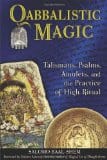 Qabbalistic Magic: Talismans, Psalms, Amulets, and the Practice of High Ritual, by Salomo Baal-Shem
Qabbalistic Magic: Talismans, Psalms, Amulets, and the Practice of High Ritual, by Salomo Baal-Shem
Destiny Books, 9781594773587, 470 pp., 2011
There are books aplenty on magic and its many side paths, but there are only a few of which I can truly say, ‘this is unique, this is something you must have on your shelf, this is a book you will turn to again and again.’1
– Dolores Ashcroft-Nowicki
Ashcroft-Nowicki is right, this is just such a book and it’s very refreshing to see. What makes this book on Qabalistic magick so different? No lengthy tables of associations for the Spheres and Paths, no cross-pollination or paradigms, no Christianization; this book is about the Jewish Qabalah, rather than the altered form more popular in Western Magickal Traditions.
The book claims to cover “all aspects of traditional Qabbalistic and Jewish magic, from the earliest sources to the (relatively recent) developments in Eastern Chassidism”2 and while I don’t know about all, it certainly covers a lot. History moves into Names of God, to Intention, Spells, Psalms, Qamea, Angels and more. Practices range from ones that are clearly products of the early Renaissance, to ones that seem to have their origin in the Babylonian exile, a wide-scope of time and practice is covered, and just adds to the appeal of this book.
This isn’t a book of solely “high magick” seeking to unite the Baal-Shem (Master of the Name, or magickian) with the Divine, but there are definitely sections that are geared toward the fabled vision of the Merkavah. There are rituals to call upon Elijah, the Maggid (which is explained as a sort of inner plane teacher), creation of a Golem, and ritual items just to raise you to the Divine. Though there are also more day-to-day rituals, everything from spells to help your fishing, to stopping gossip, to finding love, and healing, as well has how to create demon bowls or magic bowls.
For the most part the book is very good at explaining the why with the what. The author doesn’t just toss a list of “do this!” at the reader and expect obedience, there is a lot of theory and explanation to why things were done as they were, and in some cases if they still need to be done that way. Personally I always love when an author gives the why, and in this case it really helps the reader understand the Jewish tradition, as well as see how/where some things got mangled as they were co-opted into the Hermetic Qabalistic tradition.
There were several points that make the linguistic and historian in me quite happy too. The author generally insisted on spelling names properly, rather than traditionally, by which I mean the non-Jewish tradition. So names like Gabriel are rendered as Gavriel. Also many rituals were placed in context of time or place, which helped me to understand more of the structure.
I would definitely recommend this book to Qabalistic magickians, it is probably nothing like you’re used to, but it is important to understand the basis of your tradition, and you may even find some new inspiration from older methods, I certainly did.








